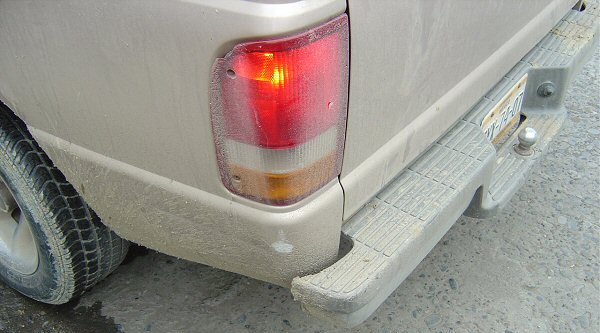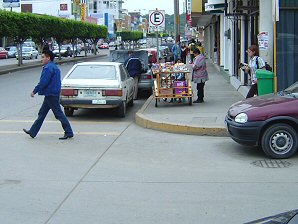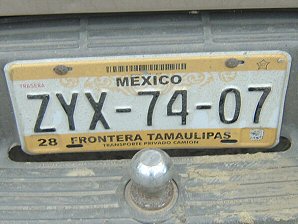Mexico Travel Tips And Advice.
For Driving And Touring Mexico.
George & Eve DeLange
 |
| Photo Of A Very Small Accident That Happened To Our Rental Car. This Is The Bad Guys Truck And He Did A Hit And Run To Us, We Caught Him! It Caused A Dent In Ours. That Could Have Cost Us Plenty. He Never Paid! We Owed Nothing! In Mexico, If You Drive... BUY MEXICAN AUTO INSURANCE !!!! USA Auto Insurance is no good in Mexico! |
|---|
We Are Proud Of Our SafeSurf Rating!
Click On This Link
To Purchase Auto Insurance In Mexico. No Obligation!
Click On The Link Below To See Good Maps Of Mexico
The Locals, ( Taxi Drivers Included ) Use the "Guia Roji Mexico Road Atlas"
We Highly Recommend It!!!
DRIVING IN MEXICO:
RULE #1:
If you are renting a car in Mexico (which we recommend), The same rules apply, except purchase the insurance through the rental company. Buy full complete coverage!! We recommend only using the large well known rental companies that also operate in the USA or Canada. That way when you get back home you might have some sort of legal action you can take against them, if you need to do so. A little known fact is that most US auto insurance will pay damages to others, just like in the USA. The problem is that the Mexican Government does not recognize USA auto insurance. Thus, you could go to jail! Canada insurance does not extend into Mexico. NOTE: To drive in Mexico, the minimum required insurance coverage is Civil Liability Insurance. This coverage protects you in the event you cause bodily injury or property damage to third parties. Be careful, there are all kinds of tricks used by insurance companies by using split limits that could leave you holding the bag. Even if you are not concerned about protecting your own vehicle with Full Coverage Insurance, you must at a minimum always purchase Mexican Liability Auto Insurance to cover any damages you may cause to third parties. Legal Service is also an important aspect of Mexican auto insurance that you should not go without. Basically there are three other types of coverage that you should have. Your rental company can give you the details at the time of rental.
LDW (Loss Damage Waiver):
This is a protection plan that has the widest and most transparent risk coverage in the domestic market, with the added advantage of a 0% deductible. This coverage protects you against total and partial theft and any type of material damage to the rental car. It is the easiest and most complete protection you will find, restrictions may apply.
ALI ( Additional Liability Insurance):
This is an additional protection that extends a cover to the driver of Civil Responsibility up to a limit that you purchase. This coverage protects the driver of the reclamations that third parties make exclusively against the driver of damages in their properties and their integrity caused by the use or handling of the rental car.
PDW (Partial Damage Waiver):
With this insurance you will only be responsible for the payment of a deductible amount that you predetermine. It covers damages to the rental vehicle and total lost as a consequence of an accident or robbery, including missing pieces or accessories. Some restrictions may apply. ALSO: Most policies only apply to the designated driver. If your party will have more than one driver they also must be listed and a fee charged for them to be covered. If this is not done and they have a wreck, they and you are uninsured! It could be jail time!
NOTE: Several credit card companies premium credit cards include some of these coverages as a benefit for using their credit cards to purchase your car rental. You must check with your credit card company and if they provide the coverage you must advise the rental car company at the time of paying for your rental. Then they can verify the coverage with the credit card company. Otherwise you will not get the free coverage.
RULE #2:
BRING A VALID DRIVERS LICENSE:
United States Citizens and U.S. Military Personnel: A renter or any additional authorized driver who is a citizen of the United States, must present at the time of rental: (1) a driver's license issued by any state, territory or possession of the United States, and valid for the entire rental period, or (2) a temporary driver's license, valid for the entire rental period, or (3) a traffic citation issued as a temporary license, valid for the entire rental period (the court date being the expiration date) and a second form of identification with signature (excluding the credit card used for rental), or (4) a valid U.S. military identification card plus an expired driver's license for active duty U.S. military personnel in those states where active duty U.S. military can drive on an expired driver's license. Active duty U.S. military personnel should contact the rental car location directly where he/she intends to rent a vehicle or be an additional authorized driver.
Canadian and Other Foreign Citizens: A renter or any additional authorized driver who is a citizen of Canada, must present at the time of rental, a driver's license issued by any province of Canada, and valid for the entire rental period. Most rental companies accept foreign-issued driver's licenses at most of their locations. An International Driving Permit is not acceptable without the driver's license of the issuing country.
RULE #3:
You will destroy your car driving in Mexico! It is worth the expensive rental fee you will be charged just to avoid the damage you will do to your personal vehicle. The average two-lane road in M�xico is clogged with diesel trucks, busses, and passenger cars. Most M�xican roads lack adequate shoulders and many miles of them have steep drop-offs where the pavement meets the dirt. Two-lane roads usually are narrower than what you are used to. Older roads are the narrowest. Lane widths throughout the country vary from about ten feet to sixteen feet. Many four-lane highways were converted to tollways. Older four lane roads have narrower lanes than our interstates. Highways built in the eighties and nineties have wider lanes. Drivers new to M�xico find driving on the toll roads expensive but easy. It is usually worth the fee. M�xico does not employ the same construction techniques when constructing or maintaining their highways. Road surfaces are usually very rough and full of deep potholes.. SPEED BUMPS ARE EVERYWHERE: THEY WILL RUIN YOUR CAR. Speed bumps can range from rippled concrete "Vibradores", to square concrete 10-12 inches high. They are even on some high speed toll roads. About 1/4 of them are not marked in any way. Where they are marked with a sign, the sign is usually nowhere near the speed bump. Speed bumps often blend in with the roadway and you can not see them. Really big speed bumps must be approached by first coming to a complete stop, then by easing your car over them. They are known as "Topes" (TOW-pays). Very few solitary topes are encountered, so beware of successive topes. It takes just one scare encounter with an unexpected tope and you will remember them forever.
After we put over 5500 miles on the rental car, the undercarrage was damaged, the muffler had holes in it, and the shocks were ruined. The car had 300 miles on it when we checked it out. We drove below speed limits and we really were very careful.
RULE #4:
Ninety percent of the fatal accidents in M�xico occur between dusk and dawn. Drinking drivers, obstacles, and hazards that challenge your daytime driving skills are still there but you won't see them as well. M�xican cars often have either no lights or blazing high beams that do not dim for oncoming traffic. Cattle congregate on the warm asphalt. Signs are difficult to read. We even met an unmarked hole in the road at night that completely took out one lane of a narrow two lane road and the drop off went about 400 feet down a mountain and into a river. The elevation at that point was about 11,000 feet on a mountain in Chiapas. Driving at night in M�xico is best left to those who think they are immortal.
RULE #5:
RULE #6:
To acquire a permit simply drive your vehicle to a Mexican customs office at the border and present the original and two copies of the following documents: Valid proof citizenship (passport or birth certificate) and tourist card Valid, original vehicle registration (must be in vehicle driver�s name) or original title A valid driver�s license (must be in vehicle driver�s name) A major credit card (must be US or Canadian issued card - not a checking account �debit card�; Visa, Mastercard, American Express, Diners; card must be in driver�s name)A fee is paid (no cash accepted; credit cards only) of $18-19 US (depending on peso exchange rate) for a multiple entry permit valid for 180 days. A permit copy isgiven to the driver and a hologram is applied to your windshield. Note that the permit copy and hologram must be returned at the border (look for �Hacienda� office sign) when departing Mexico. Otherwise, subsequent vehicle entry into Mexico may be denied. Get return receipt from Customs Official. This is not all you need to know but it is a general view of driving in Mexico. Don't be afraid to do it. It is the best way we know to get around when down there. When in large crowded cities, we parked the rental car in a guarded hotel parking lot and used taxies. It's cheap and easy on your nerves. Just be very careful when driving!
Disclaimer:
|
 |  |
| A Bad Guy. Parked In This Crosswalk. Backed Into The Rear Side Panel. Of Our Rental Car. | License Plate Of Bad Guy. He Never Paid Anything! He Had No Insurance. Or Money! |
|---|---|
 |  |
| Typical Tope. Difficult To See. Easy To Hit At Night. Note: Dust Clouds In Background | Look Where Drivers Damaged Cars. On The Chipped Places On The Tope. Imagine Hitting This In A Dust Storm |
 |
| Tope Sign Don't Expect Signs! |
|---|
We Are Proud Of Our SafeSurf Rating!
Click On The Link Below To See Good Maps Of Mexico
The Locals, ( Taxi Drivers Included ) Use the "Guia Roji Mexico Road Atlas"
We Highly Recommend It!!!
Other Mexico Web Pages !
|
|
|---|
| Back To Ancient Possible Book Of Mormon Lands Page
|
| Back To Mexico; Sites, Cities, & Advice Page
|
| Back To Mexico Trips Main Page
|
| Back To DeLange Home Page |




